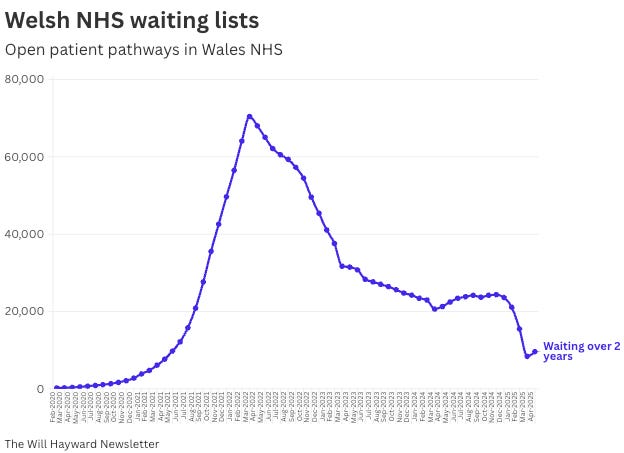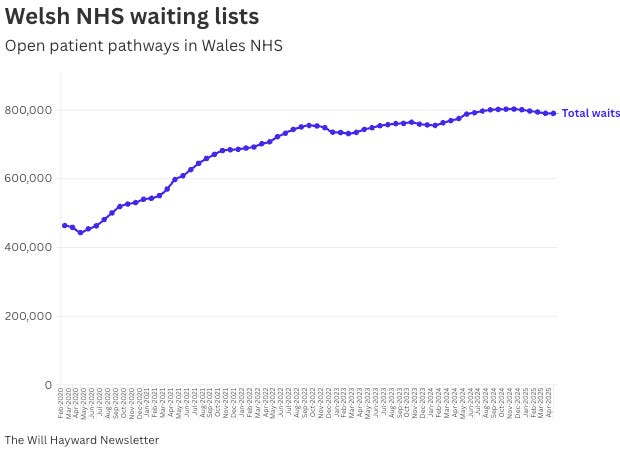Hello!
This week I want to look at one way Wales is getting screwed over that you have probably missed. We will then dive into how Cymru having the oldest houses in Europe is making tackling our other problems so hard, before looking at how likely Plaid Cymru are to win next year.
I also wanted to mention that next week I will be reporting from the Welsh Labour conference in Llandudno (gosh I hope it is as funny as the Welsh Tory one). This will involve travel and three nights in a hotel. As an independent journalist, I am only able to do this because people support this newsletter. You are directly funding my reporting. It is a fantastic model for funding journalism and I am very grateful to all who put their hand in their pocket to let me do it.
If you would like to support this newsletter please consider becoming a paying subscriber.
Before we start, a word from our sponsor:
This newsletter is sponsored by Hello Starling. A proudly Welsh company, Hello Starling plan and buy media, backed by data, which is designed to get maximum attention and measurable results. They specialise in getting eyes on your organisation, product and website. If you are looking to get a return on investment, a change in perception, more visitors, more subscriptions, a bigger audience or a happier audience, I highly recommend you check them out here. In doing so you help support this newsletter.
The terrible UK Government decision that has gone unnoticed
We have talked extensively on this newsletter about the UK Government’s plans for disability benefit and winter fuel payments, but there has been a decision which very few people have been speaking about which probably deserves far more attention than it has - local housing allowance.
The reason this is being missed in the coverage is that it’s a bit complicated, but it is so worth two minutes of your time to get your head around.
Firstly, what is the local housing allowance (LHA)?
It is not a benefit. It is the maximum amount of housing support those on benefits can get towards their private rented house. Think of it as a cap. If the cap is £500 but your rent is £800, you have a shortfall of £300.
But the crucial thing is how it is set, because it is different depending on where you live. It used to be that it was set in the 50th percentile for an area - meaning you can rent the averagely house for where you are. But George Osborne changed this to the 30th percentile. Then they kept freezing it year after year, meaning the standard of house you could afford just got lower and lower below that 30th percentile.
Mr Osborne’s theory was that if you did that, rents wouldn't rise as quickly because people had less money to spend. What actually happened was rent rose really quickly, and homelessness went up as well. So odd for George to make such an error.
However, in April last year Rishi Sunak unfroze the LHA and it went back to the 30th percentile. But when Labour’s Liz Kendall took over, she froze it again in the name of cost saving. So one of the first acts of the new Labour UK Government was to refreeze the rate.
This is so stupid - the fallacy that this saves money

What is most annoying about Liz Kendall’s “cost saving” measure is that it increases costs. Yes it will reduce the expenditure on the DWP budget but all it does is disproportionately increase spending in other areas such as tackling homelessness in local authorities.
Just for context, the cost to the taxpayer of someone being homeless is on average £20,000 per household! The cost of homelessness to wider public services in Wales is £64m a year and the total societal cost is £485m per year. Freezing LHA is such a stupid way to save money. It is the appalling shortsightedness that we came to expect for the Conservatives.
Ruth Power, CEO of Shelter Cymru, said:
“Housing benefit is meant to be an integral part of preventing homelessness, providing a vital safety net for those who are struggling. However, the decision to once again freeze the amount of support available undermines its ability to do this and puts many households at risk of homelessness.”
Why this hits Wales harder…
Obviously LHA impacts people across the UK. But it is worse for Wales because rent is rising faster here than any other part of the UK.
According to the ONS, this is how much average rents had increased by in the UK in April for the previous 12 months:
8.7% in Wales
7.5% in England
5.1% in Scotland
In some areas the gap between rent and housing benefit is set to be even more severe, with a family in need of a four-bed home in Newport facing an annual shortfall of more than £3,000. Meanwhile a family looking for a three-bed in Wrexham will need to find almost £900 on top of what they are eligible for.
Welsh Labour’s view is irrelevant to their UK counterparts
The Welsh Government has long been calling for LHA to be put back up to the 50th percentile. They have argued this consistently through the Tories’ 14 years in office. Now that their UK colleagues are in, they seem to have been a bit quieter…
The Welsh Gov do have their own schemes to try and stop homelessness but you will perhaps not be surprised to hear that they are not always that effective.
One scheme they have is called “Help to Stay” and that was for people struggling to pay their mortgages.
It was launched in November 2023 with £40m allocated to provide equity loans to households struggling with affordability. Households wouldn’t have to start paying back these loans for the first five years, helping reduce monthly repayments to a more manageable level.
Good right? Well apart from the fact that across the first 12 months of the scheme just five loans were approved from 59 applications…
You can see a good breakdown of the issue on Shelter Cymru’s blog here.
Do you have a business, product, brand or event you want to promote? Consider sponsoring this newsletter.
It is read over 50,000 times a month and drops directly into the inbox of leaders across Wales. Plus, you directly support my journalism and enable me to ask difficult questions of those in power.
Email will@willhayward.co.uk for more info.
The disastrous state of Welsh housing
When we talk about Wales, the issue that often comes up is health. But what is often spoken about far less, and is doing a lot to drive the health crisis Wales faces, is the issue of housing.
Let me give you some context for housing in Wales because we not only have the oldest housing stock in the UK. We also have an older housing stock than any EU country!
When it comes to the number of houses built before the end of the First World War, Wales has over a quarter:
What makes these figures even worse is that the Welsh data only includes occupied properties whereas England and NI include vacant dwellings.
When it comes to the percentage of Welsh homes defined as in “poor condition” Wales has the most again with 18%, whereas England has 15% and NI just 9% (Scotland gathers its data in a different way so it is hard to compare).
Make no mistake, the older a house, the more likely it is to be of poor quality:
So what is the cost of this? Obviously it’s hard to give an exact figure for the impact this has on the health service in Wales but there are some decent estimates. Let’s take a look at some from a 2019 Public Health Wales report.
The issues with poor quality housing come in many forms. It can include them being damp or cold, but also problems in layout that make falls much more likely. Many of Wales’ older houses have really narrow and steep stairwells to accommodate our hilly landscape. Here is an example:
This is not uncommon. If an elderly person was to have a fall on the steps the outcome would likely be severe. If they were to survive then and suffer paralysis this would cost the NHS about £90,000 per year to fund.
While it would cost a significant amount of money to mitigate all the issues with Wales’ housing stock, it would actually pay for itself REALLY quickly. Here are some estimates (the column at the end is how many years it would take for the improvements to pay for themselves):
So if you spent £200m making Welsh houses warmer, the NHS has made those savings back in less than half a decade. This is such a no brainer. And this is not to mention the fact that this will make people’s lives much better.
If you improved Wales’ housing stock, Welsh society would benefit to the tune of £1bn a year. This is serious cash. This doesn’t event take into account:
Increases in people’s home values
Reduction in maintenance costs
Lower energy costs
Lower CO2 emissions
Potentially lower insurance promise
Again and again in this newsletter we talk about how in Wales and the wider UK, we have become so conditioned to treating symptoms and not causes of problems. Housing is a great example of this.
Welsh waiting lists spike
Every month we track the changes in the longest Welsh NHS waiting lists. After months of rapid rises, the figures started to go up again. Health minister Jeremy Miles put it down to routine April pressures.
While the increase is really concerning, other news sites have covered it. What I want to focus on is what I believe to be a highly ambitious claim. Namely that the Welsh Gov would “reduce the overall size of the waiting list by 200,000” by March 2026.
To be clear, this is a hugely ambitious target. More ambitious than the two-year wait target. So ambitious I simply do not have any faith they will manage it. Take a look at this graph:
It shows the total waits in the Welsh NHS. The Welsh Government say they want to get this figure from 800k down to 600k but this line has barely moved for three years. The idea that they are going to be able to, in the space of 12 months, make that change is fanciful (I really hope I am proved wrong).
To do this they say they are injecting an additional £120m to make these changes. But in NHS terms this is only about 1% of the budget. If this is what is needed, why the hell haven’t they done this already?
Plaid Cymru - Wales’ next government?
Last week we did a SWOT analysis of Welsh Labour looking at their strengths, weaknesses, opportunities and threats heading into the next election. Thanks to all the people who gave their feedback and found it useful. Remember this list is not exhaustive and please let me know what I have missed.
Plaid Cymru
Leader: Rhun ap Iorwerth
Current seats: 12/60
Predicted seats (according to last poll): 35/96 (up 23)
Strengths
Seen as able to win. For the first time there is a real feeling that Plaid could be the largest party. It is so much easier for parties to win votes if the public believe there is a credible chance of them winning.
Rhun ap Iorwerth. The Plaid leader is a former broadcast journalist and a really effective communicator. He is also a pragmatic politician. He managed to position his party away from issues like Welsh independence (though they are still unequivocally supportive of it) and instead is focusing on issues that will win them seats outside of their base.
Not Labour. It might sound churlish to say, but not being Labour is perhaps their greatest strength. Across the world parties considered to not be part of the establishment are performing very well compared to the established ones, and you don’t get more established in Wales than Labour.
Widely seen as pro Wales. In an era where identity is increasingly important when it comes to predicting voting, and with the number of people identifying as Welsh increasing every year, Plaid Cymru being viewed as “standing up for Wales” is a huge strength for them. Expect this to be front and centre of their messaging over the next year.
Actual policies. As a party, Plaid Cymru's bloody love policy. Over the last eight months they have put forward some fairly detailed policy proposals. This is going to be really helpful in portraying themselves as serious about governing, especially when compared to Reform and the Tories.
Weaknesses
Keep reading with a 7-day free trial
Subscribe to The Will Hayward Newsletter to keep reading this post and get 7 days of free access to the full post archives.











